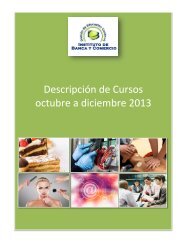ENFE 1611 Emergency Situations and First Aid(1 credits)Pre-requisites: NoneA first aid course which covers the assessment and initial treatment of the patient during emergencies, suchas wounds, fractures, hemorrhages, artificial breathing methods, and all types of techniques used in thesecases.CURE 1002 Cardiovascular Pathophysiology and Evaluations(4 credits)Pre-requisite: EMME 1020Stu<strong>de</strong>nts study the different pathologies of respiratory diseases. Stu<strong>de</strong>nts learn the symptoms, patientevaluation, classification of conditions, and treatment alternatives. Stu<strong>de</strong>nts complete an entire patientanalysis and treatment chart for bronchitis, pneumonia, and other cardio-respiratory diseases.CURE 1036 Introduction to Cardiovascular Pharmacology(2 credits)Pre-requisite: NoneThis course inclu<strong>de</strong>s several aspects of pharmacology such as the formulation, dosage, control management,effects, metabolism, and available information on applicable legislation on drugs and medicines used in theprofession.TERE 1003 Diagnostic Tests (EKG, ABG’S, PFT, and Lab)(3 credits)Pre-requisite: Concurrent with CURE 1002Focus is placed on medical terminology, assessment, testing procedures, equipment, and imaging of RCT.Inclu<strong>de</strong>d are: pulmonary functions testing, chest X-ray, CT, MRI, hazard involved, confi<strong>de</strong>ntiality of recordkeeping, therapies available for the diseases, and rehabilitation process.LTER 1001 Respiratory Care (Medical Gas, Aerosol and Other Therapies)(3 credits)Pre-requisite: CURE 1002Information and laboratory practice on management of patient requiring life support. The emphasis is onmo<strong>de</strong>s of ventilations, indications, humidity therapy, aerolized drugs, aerosol therapy, bronchodilators,bronchoscope, suctioning, intubations, and intubations, and hygiene rules. Inclu<strong>de</strong>d are assessment offrequently used ventilators, types of airways, and operational techniques. Theory and <strong>de</strong>monstrations onthe application of humidity therapy, bland aerosol therapy, therapeutic aerosols, bronchodilators,bronchoscopes, suction, dry power inhalators, equalizers, atomizers, and other gases.CURE 1001 Respiratory Ducts and Suction(3 credits)Pre-requisite: EMME 1020This course integrates everything learned from the other courses into a clinical simulation. The stu<strong>de</strong>nts useall of the different techniques learned through the theory and practice courses. Emphasis is given to thecorrect use and management of breathing and suction equipment.CURE 2010 Mechanical Ventilation I (Adults)- Lab(3 credits)Pre-requisite: CURE 1002Practice with pulmonary and respiratory therapies for normal and acute/critical adult patients. Stu<strong>de</strong>ntspractice with water-based therapies, drugs, bronchial tubes, suction tubing, and other therapies. Stu<strong>de</strong>nts learna<strong>de</strong>quate aseptic measure, <strong>de</strong>contamination procedures, equipment cleaning and sterilization, and how tohandle ventilators and suction <strong>de</strong>vices. Stu<strong>de</strong>nts also learn how to evaluate the adult patient on a respirator.CURE 2011 Mechanical Ventilation II (Neonatal)- Lab(4 credits)Pre-requisite: CURE 2010Practice with pulmonary and respiratory therapies for normal and acute/critical neonatal patients. Stu<strong>de</strong>ntspractice with water-based therapies, drugs, bronchial tubes, suction tubing, and other therapies. Stu<strong>de</strong>nts learna<strong>de</strong>quate aseptic measure, <strong>de</strong>contamination procedures, equipment cleaning and sterilization, and how tohandle ventilators and suction <strong>de</strong>vices. Stu<strong>de</strong>nts also learn how to evaluate the neonatal patient on a- 138 -
espirator.PRTR 2001 Clinical Practice (Externship)- Phase I(5 credits)Pre-requisite: Approved all previous courses, except CURE 2011, TERE 1004 and PRTR 2002Real life experience where the stu<strong>de</strong>nt practices un<strong>de</strong>r the supervision and coordination of a specialist in thisarea. It is consi<strong>de</strong>red an advanced skills practice on therapy applications.TERE 1004 Preparatory Course for Respiratory Thechnician Board Exam(2 credits)This course will prepare the stu<strong>de</strong>nt for take the Puerto Rico Respiratory Care Therapy Board Exams, inor<strong>de</strong>r to become a licensed respiratory care technician. Instruction inclu<strong>de</strong>s: Description of theoccupation, Description of the Board By Laws, Reviewing of topic inclu<strong>de</strong>d in the exams, such as: basicmathematics, general sciences, anatomy /physiology, microbiology, oxygen ventilation, mechanicalventilation, CPR, medications and equipment/materials used and the study of the laws and regulationsrelated to the occupation. Also inclu<strong>de</strong> simulated board exam taking practices.PRTR 2002 Clinical Practice (Externship)- Phase II(7 credits)Pre-requisite: PRTR 2001Second part of the of a Respiratory Care Technician level practicum inclu<strong>de</strong>s performance of basic skillsun<strong>de</strong>r minimal supervision, performance, of critical care un<strong>de</strong>r mo<strong>de</strong>rate supervision and observation andperformance un<strong>de</strong>r direct supervision of a specialist in the respiratory care field.DENTAL ASSISTANT WITH EXPANDED FUNCTIONSEMME 1020 Anatomy and Physiology Principles(3 credits)Pre-requisite: NoneThe stu<strong>de</strong>nt will obtain structured and integrated knowledge of all the organs and systems of the human body.At the same time the stu<strong>de</strong>nt will learn the normal functions of all the corporal systems and the way in whichsuch functions can be <strong>de</strong>termined.ASDE 1001 Dental Anatomy(3 Credits)Pre-Requisites: NoneThis course provi<strong>de</strong>s educational activities to make the stu<strong>de</strong>nt able to i<strong>de</strong>ntify and un<strong>de</strong>rstand the <strong>de</strong>ntalanatomy with emphasis on structures of the oral cavity, terminology, tooth morphology, embryology andhistology of the head region and oral cavity.ASDE 1010 Head and Neck Anatomy(3 Credits)Pre-Requisites: NoneThis course provi<strong>de</strong>s educational activities to make the stu<strong>de</strong>nt able to i<strong>de</strong>ntify and un<strong>de</strong>rstand the Headand neck anatomy. Topics to be covered inclu<strong>de</strong> embryonic <strong>de</strong>velopment of the head and neck, alongwith i<strong>de</strong>ntification of the bones in the skull. Muscles of the head and neck will be i<strong>de</strong>ntified along withtheir functions, insertion and origins. The vascular, lymphatic and nervous systems of the head and neckwill be discussed along with the anatomical basis of the spread of infectionASFE 1000 Preventive (Oral Health and Nutrition)(3 Credits)Pre-Requisites: NoneA study of general nutrition with emphasis on the effects of nutrition and <strong>de</strong>ntal health, diet, and theapplication of counseling strategies to assist the patient in attaining and maintaining optimum oral health.ASDE 2001 Dental Materials(3 Credits)Pre-Requisites: NoneIntroduced to the basic principles of <strong>de</strong>ntal materials science. This inclu<strong>de</strong>s the physical, chemical,- 139 -
- Page 5 and 6:
PASS (APPROVED)/NOT PASSED (NOT APP
- Page 7 and 8:
PRESIDENT’S MESSAGEInstituto de B
- Page 10:
Structural1. Develop an organizatio
- Page 23 and 24:
ADMINISTRATIVE OFFICERSMANATÍ CAMP
- Page 28 and 29:
ADMINISTRATIVE OFFICERSARECIBO CAMP
- Page 31 and 32:
CAMPUS ADDITIONSInstituto de Banca
- Page 33 and 34:
STUDENT SERVICESACADEMIC COUNSELING
- Page 35 and 36:
Federal Direct LoanThe Federal Dire
- Page 37 and 38:
POLICY RELATED TO SCHOOL VACCINATIO
- Page 39:
PROGRAMS LEADING TO AN ASSOCIATE DE
- Page 42 and 43:
6. The transcript of credits will i
- Page 44 and 45:
5. If the student has processed a g
- Page 46 and 47:
j. During weeks seventeen and ninet
- Page 48 and 49:
The Institution will not make chang
- Page 50 and 51:
DEADLINE FOR SUBMITTING A PARTIAL O
- Page 52 and 53:
are considered as Intended Credits
- Page 54 and 55:
Minimum Cumulative AverageFor each
- Page 56 and 57:
policy during the probationary peri
- Page 58 and 59:
ight of first sale, the TEACH Act,
- Page 60:
ASSOCIATE DEGREE PROGRAM:REGIONAL A
- Page 63 and 64:
BANKING OPERATIONSThis study progra
- Page 65 and 66:
MEDICAL SECRETARY WITH WORD PROCESS
- Page 67 and 68:
COMPUTER SYSTEMS ADMINISTRATIONThe
- Page 69 and 70:
REGIONAL AND INTERNATIONAL CUISINET
- Page 71 and 72:
BARTENDINGThis program offers our s
- Page 73 and 74:
EMERGENCY MEDICAL TECHNICIAN - PARA
- Page 75 and 76:
HOME HEALTH CARE ASSISTANTThe stude
- Page 77 and 78:
DENTAL ASSISTANT WITH EXPANDED FUNC
- Page 79 and 80:
PROFESSIONAL MASSAGE THERAPISTThis
- Page 81 and 82:
COMPUTER REPAIRS AND NETWORK TECHNI
- Page 83 and 84:
REFRIGERATION AND AIR CONDITIONING
- Page 85 and 86:
PLUMBING TECHNICIANThis study progr
- Page 87 and 88: COSMETOLOGYThis program offers stud
- Page 89 and 90: NAIL TECHNOLOGYThis program offers
- Page 91 and 92: ESTHETICSThis program offers to our
- Page 93 and 94: ASSOCIATE DEGREE PROGRAMSASSOCIATE
- Page 95 and 96: NURS 2300 Evaluation, Emergencies M
- Page 97 and 98: Apply the principles of confidentia
- Page 99 and 100: COLI 2005 Menu and Facility Plannin
- Page 101 and 102: DIPLOMA PROGRAMSBANKING OPERATIONSL
- Page 103 and 104: INGL 1107 Basic English II(3 credit
- Page 105 and 106: mail, appointments, contacts, tasks
- Page 107 and 108: CODI 3000 Diagnostic, Codification
- Page 109 and 110: OPCO 2093 Computer’s Operating Sy
- Page 111 and 112: SERE 3000 Network Security(3 Credit
- Page 113 and 114: Exam for Microsoft PowerPoint. This
- Page 115 and 116: GEOG 1006 Universal Tourism Geograp
- Page 117 and 118: to operate instruments and equipmen
- Page 119 and 120: REFRIGERATION AND AIR CONDITIONING
- Page 121 and 122: AIRR 2001 Automotive Air Conditioni
- Page 123 and 124: DELI 3020 Plumbing Distributions(3
- Page 125 and 126: ELED 1041Fundamentals of Electricit
- Page 127 and 128: hands on exercise sessions, and hom
- Page 129 and 130: junctions will be studied including
- Page 131 and 132: division.EMME 2001 Handling of Haza
- Page 133 and 134: Delivery Room and Medical Emergency
- Page 135 and 136: ENFE 2605 Psychiatrics Nursing(2 cr
- Page 137: ASSH 1004 Clinical Externship(10 cr
- Page 141 and 142: office. Verbal and written communic
- Page 143 and 144: LTES 1002 Surgical Room- Lab(2 cred
- Page 145 and 146: dysfunctions related to fractures,
- Page 147 and 148: ESPA 1005 Basic Spanish(3 Credits)P
- Page 149 and 150: search of information and services.
- Page 151 and 152: BARR 1012 New Cocktail Tendencies (
- Page 153 and 154: FACI 1001 Facility and Menu Plannin
- Page 155 and 156: cost controls on the preparation of
- Page 157 and 158: future job opportunities.ADMI 2032
- Page 159 and 160: preparation for the procedure, and
- Page 161 and 162: COSM 1100 Hair Care Principles and
- Page 163 and 164: NAIL TECHNOLOGYCOSM 1001 The Profes
- Page 165 and 166: COSM 3101 Advanced Techniques of Ha
- Page 167 and 168: disorders. The student will be acqu
- Page 169 and 170: ACADEMIC OFFERING BY LOCATION, OCCU
- Page 171 and 172: BAYAMONPROGRAMS OFFEREDPROGRAMS NOT
- Page 173 and 174: SAN JUAN (CAROLINA)PROGRAMS OFFERED
- Page 175 and 176: FAJARDOPROGRAMS OFFEREDPROGRAMS NOT
- Page 177 and 178: HATO REYPROGRAMS OFFEREDPROGRAMS NO
- Page 179 and 180: MANATIPROGRAMS OFFEREDPROGRAMS NOT
- Page 181: PONCEPROGRAMS OFFEREDPROGRAMS NOT O
- Page 184 and 185: Diploma ProgramEmergency Medical Te
- Page 186 and 187: Related Employment OpportunitiesPro
- Page 188 and 189:
Related Employment OpportunitiesRes
- Page 190 and 191:
Related Employment OpportunitiesInt
- Page 192 and 193:
Related Employment OpportunitiesTou
- Page 194 and 195:
Diploma ProgramNail TechnologyRelat
- Page 196 and 197:
Related Employment OpportunitiesAdv
- Page 198 and 199:
Diploma ProgramBanking OperationsRe
- Page 200 and 201:
Related Employment OpportunitiesInf
- Page 202 and 203:
Occupation NameSOC Code Please visi
- Page 204 and 205:
Diploma ProgramDrafting and Compute
- Page 206 and 207:
Diploma ProgramRefrigeration and Ai
- Page 208 and 209:
Related Employment OpportunitiesReg
- Page 210 and 211:
Related Employment OpportunitiesRes
- Page 212 and 213:
Associate Degree ProgramNursingRela
- Page 214 and 215:
INSTITUTO DE BANCA Y COMERCIO- 213
- Page 216 and 217:
- 215 -
- Page 218 and 219:
PROGRAM COORDINATORS FACU
- Page 220 and 221:
FAJARDO ADDITIONAL LOCATIONPROGRAM
- Page 222 and 223:
Rodríguez Figueroa Anabelle. Diplo
- Page 224 and 225:
MAYAGÚEZ ADDITIONAL LOCATIONPROGRA
- Page 226 and 227:
Cortes Cortes, Junielle. Diploma, E
- Page 228 and 229:
Gordils Jiménez, Denisse. B.B.A. S
- Page 230 and 231:
Muñiz Jimenez, Redames. Diploma, E
- Page 232 and 233:
Rodríguez Cintrón, Alexmar. Diplo
- Page 234 and 235:
Vazquez Rivera, Yomara. Diploma de
- Page 236 and 237:
Rico. Artes Culinarias, Cocina Loca
- Page 238 and 239:
CAYEY ADDITIONAL LOCATIONPROGRAM CO
- Page 240 and 241:
Rico. Belleza, Cosmetología.Parril
- Page 242 and 243:
CAROLINA ADDITIONAL LOCATIONPROGRAM
- Page 244 and 245:
Montijo Resto, Daihana.. Diploma en
- Page 246 and 247:
Latalladi Resto, Juan. Diploma en D
- Page 248 and 249:
TUITION COSTS AND OTHER FEES- 248 -
- Page 250 and 251:
Practical Nursing $25.00 $9,780.00P
- Page 252 and 253:
ACADEMIC CALENDAR- 252 -
- Page 254 and 255:
Summer Term / April 29, 2013 - Augu
- Page 256 and 257:
Spring Term / January 7, 2014 - Apr
- Page 258:
Fall Term / August 25, 2014 - Decem


![cata espa revision 06252010 [todo] - Instituto de Banca y Comercio](https://img.yumpu.com/41236273/138/500x640/cata-espa-revision-06252010-todo-instituto-de-banca-y-comercio.jpg)
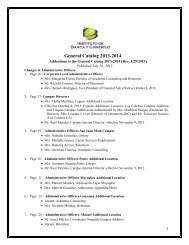
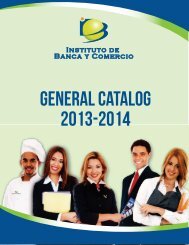
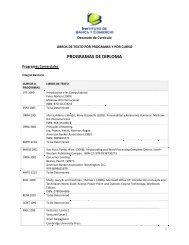
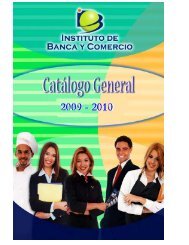
![CATA ING REV 8/08 [LARGO] - Instituto de Banca y Comercio](https://img.yumpu.com/44199430/1/190x245/cata-ing-rev-8-08-largo-instituto-de-banca-y-comercio.jpg?quality=85)
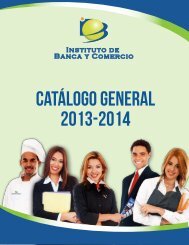
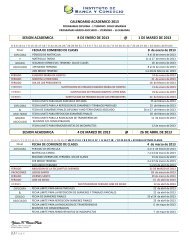

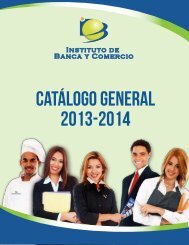
![CATA ING REV 8/08 [LARGO] - Instituto de Banca y Comercio](https://img.yumpu.com/40577524/1/190x245/cata-ing-rev-8-08-largo-instituto-de-banca-y-comercio.jpg?quality=85)
![cata espa revision 06252010 [todo] - Instituto de Banca y Comercio](https://img.yumpu.com/38349063/1/190x245/cata-espa-revision-06252010-todo-instituto-de-banca-y-comercio.jpg?quality=85)
![cata espa revision 06252010 [todo] - Instituto de Banca y Comercio](https://img.yumpu.com/38348971/1/190x245/cata-espa-revision-06252010-todo-instituto-de-banca-y-comercio.jpg?quality=85)

